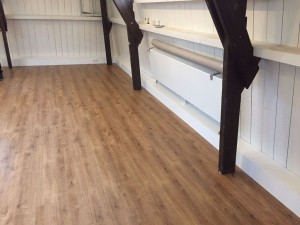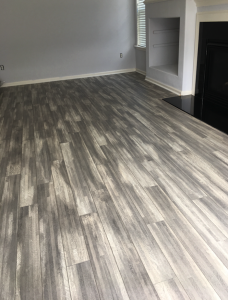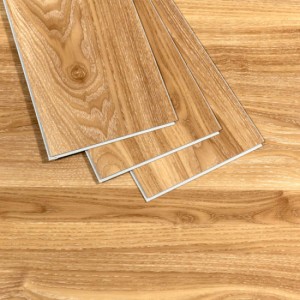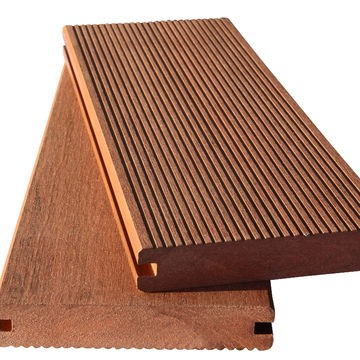1. PVC plastic flooring is a new type of light-weight floor decoration material that is very popular in the world today. It is widely used in various places such as homes, hospitals, schools, office buildings, factories, public places, supermarkets, and businesses. “PVC floor” refers to the floor made of polyvinyl chloride material. Specifically, polyvinyl chloride and its copolymer resin are used as the main raw materials, and fillers, plasticizers, stabilizers, colorants and other auxiliary materials are added to the sheet-like continuous substrate through coating process or calendering, extrusion or extrusion. The relevant national standard is GB/T11982-2015. The so-called PVC floor, commonly known as plastic floor, is a general term. Any floor made of polyvinyl chloride can be roughly called PVC floor. New types of floor such as LVT, SPC, and WPC are actually PVC. In the floor category, they just add different other materials, so they form an independent subcategory. The main components of PVC flooring include polyvinyl chloride powder, stone powder, plasticizers, stabilizers, and carbon black. These kinds of raw materials are widely used industrial raw materials, and their environmental safety has been verified for many years.
Disadvantages: too thin, conventional 2mm thickness. The foot feel is very, very poor. If the ground is uneven, it will look bumpy even if the effect is faked.
Advantages: Very cheap, suitable for low-end rental and renovation. Easy to install with adhesive backing.
2. LVT floor The above picture is LVT floor, soft and bendable elastic floor, which is professionally expressed as “semi-rigid sheet plastic floor”. They can even be bent into rolls. In the past, they were mainly used for tooling projects because it The requirements for the floor are relatively high, and professionals are required to lay it, so considering the cost, it is usually only suitable for large-scale laying. For rental houses or offices that do not require high flatness, this kind of floor is both beautiful and affordable.
The recognized advantages of LVT flooring are: cheap price, environmental protection, wear-resistant, good elasticity and impact resistance, 0 formaldehyde, waterproof and flame-retardant, waterproof and moisture-proof, and easy maintenance. This kind of floor is often laid in schools, kindergartens, play rooms, and also in family children’s rooms.
Disadvantages: The thickness does not exceed 5mm, which is relatively thin and soft. Because the material is soft, it is easy to arch in large areas.
3. SPC floor, Stone Plastic Composite, is a hard plastic floor, which can also be bent, but compared with LVT floor, the curvature is much less. Its common name is Shijing floor, which is called stone-plastic floor or plastic stone floor in Hong Kong and Taiwan. In addition to Europe and the United States, Southeast Asia is one of the regions where SPC floor is used most, because it not only has a good appearance, but also has excellent waterproof and moisture-proof performance. It is cheaper than laying floor tiles and saves laying time. In Europe, SPC flooring is called RVP flooring. It is made of one-time heating and bonding, and there is no need to use glue at all.
It has many advantages, such as high environmental protection; waterproof and moisture-proof; insect-proof and moth-proof; high fire resistance; good sound-absorbing effect; no cracking, no deformation, no thermal expansion and contraction; low price; easy installation; no formaldehyde , heavy metals, phthalates, methanol and other harmful substances.
The disadvantage of SPC is that it is dense and heavy, and the transportation cost is relatively high; the thickness is relatively thin, so it has certain requirements for the flatness of the ground.
4. WPC floor, Wood Plastic Composite is a semi-rigid sheet plastic floor, commonly known as wood-plastic floor, because the early WPC floor added wood powder, so it is called wood-plastic floor. Now that there is no wood fiber at all, it can be completely understood as a stone-plastic floor, and the material is 100% waterproof. It is composed of LVT layer and WPC layer (a layer of 1mm thick black LVT layer is added than SPC), and the foot comfort and sound absorption effect are very prominent. There is almost no difference with solid wood flooring. Its environmental protection performance is also outstanding. It has all the characteristics of LVT floor and SPC floor, and all 144 test indicators have passed. Moreover, its installation requirements are similar to those of laminate flooring. It has locks and is very convenient to install. Because WPC is thick and the material cost is high, the price is higher than LVT floor and SPC floor. There are quite a lot of WPC floors made into wall panels, background walls and suspended ceilings.
The WPC floor has a high thickness, which can be more than 8mm, and the foot feels very good, just like the wooden floor, and even has better elasticity than the wooden floor. It is warm in winter and cool in summer. If you look at Taobao, Longye flooring can be made to a thickness of 10mm. I have not seen other brands that can reach this thickness. For example, the Kendia super floor is 7mm thick, the natural floor is 8mm thick, and the Fillinger floor is only 5.5mm.
Advantages: The best foot feel, no tile change. The finish is shaded and has a real wood feel.
Disadvantages: high thickness, resulting in high cost and high price.
Post time: May-16-2023




